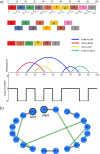The elusive evidence for chromothripsis
- PMID: 24939897
- PMCID: PMC4117757
- DOI: 10.1093/nar/gku525
The elusive evidence for chromothripsis
Abstract
The chromothripsis hypothesis suggests an extraordinary one-step catastrophic genomic event allowing a chromosome to 'shatter into many pieces' and reassemble into a functioning chromosome. Recent efforts have aimed to detect chromothripsis by looking for a genomic signature, characterized by a large number of breakpoints (50-250), but a limited number of oscillating copy number states (2-3) confined to a few chromosomes. The chromothripsis phenomenon has become widely reported in different cancers, but using inconsistent and sometimes relaxed criteria for determining rearrangements occur simultaneously rather than progressively. We revisit the original simulation approach and show that the signature is not clearly exceptional, and can be explained using only progressive rearrangements. For example, 3.9% of progressively simulated chromosomes with 50-55 breakpoints were dominated by two or three copy number states. In addition, by adjusting the parameters of the simulation, the proposed footprint appears more frequently. Lastly, we provide an algorithm to find a sequence of progressive rearrangements that explains all observed breakpoints from a proposed chromothripsis chromosome. Thus, the proposed signature cannot be considered a sufficient proof for this extraordinary hypothesis. Great caution should be exercised when labeling complex rearrangements as chromothripsis from genome hybridization and sequencing experiments.
© The Author(s) 2014. Published by Oxford University Press on behalf of Nucleic Acids Research.
Figures






Similar articles
-
Breakpoint profiling of 64 cancer genomes reveals numerous complex rearrangements spawned by homology-independent mechanisms.Genome Res. 2013 May;23(5):762-76. doi: 10.1101/gr.143677.112. Epub 2013 Feb 14. Genome Res. 2013. PMID: 23410887 Free PMC article.
-
Genomic Chaos (Multiple Copy Number Variations and Structural Reorganization) Detected in Two Prenatal Cases.Cytogenet Genome Res. 2021;161(5):236-242. doi: 10.1159/000515653. Epub 2021 Jul 16. Cytogenet Genome Res. 2021. PMID: 34274931
-
Stress induced by premature chromatin condensation triggers chromosome shattering and chromothripsis at DNA sites still replicating in micronuclei or multinucleate cells when primary nuclei enter mitosis.Mutat Res Genet Toxicol Environ Mutagen. 2015 Nov;793:185-98. doi: 10.1016/j.mrgentox.2015.07.014. Epub 2015 Jul 29. Mutat Res Genet Toxicol Environ Mutagen. 2015. PMID: 26520389
-
Chromothripsis: potential origin in gametogenesis and preimplantation cell divisions. A review.Fertil Steril. 2014 Dec;102(6):1785-96. doi: 10.1016/j.fertnstert.2014.09.006. Epub 2014 Oct 18. Fertil Steril. 2014. PMID: 25439810 Review.
-
The Genomic Characteristics and Origin of Chromothripsis.Methods Mol Biol. 2018;1769:3-19. doi: 10.1007/978-1-4939-7780-2_1. Methods Mol Biol. 2018. PMID: 29564814 Review.
Cited by
-
Novel insights and therapeutic approaches in secondary AML.Front Oncol. 2024 Jul 29;14:1400461. doi: 10.3389/fonc.2024.1400461. eCollection 2024. Front Oncol. 2024. PMID: 39135995 Free PMC article. Review.
-
CTLPScanner: a web server for chromothripsis-like pattern detection.Nucleic Acids Res. 2016 Jul 8;44(W1):W252-8. doi: 10.1093/nar/gkw434. Epub 2016 May 16. Nucleic Acids Res. 2016. PMID: 27185889 Free PMC article.
-
Chromosomal imbalances in human bladder urothelial carcinoma: similarities and differences between biopsy samples and cancer stem-like cells.BMC Cancer. 2014 Sep 1;14:646. doi: 10.1186/1471-2407-14-646. BMC Cancer. 2014. PMID: 25178926 Free PMC article.
-
Genome-Wide DNA Copy Number Analysis of Acute Lymphoblastic Leukemia Identifies New Genetic Markers Associated with Clinical Outcome.PLoS One. 2016 Feb 12;11(2):e0148972. doi: 10.1371/journal.pone.0148972. eCollection 2016. PLoS One. 2016. PMID: 26872047 Free PMC article.
-
SDRAP for annotating scrambled or rearranged genomes.NAR Genom Bioinform. 2023 Nov 2;5(4):lqad096. doi: 10.1093/nargab/lqad096. eCollection 2023 Dec. NAR Genom Bioinform. 2023. PMID: 37942284 Free PMC article.
References
-
- Molenaar J.J., Koster J., Zwijnenburg D.A., van Sluis P., Valentijn L.J., van der Ploeg I., Hamdi M., van Nes J., Westerman B.A., van Arkel J., et al. Sequencing of neuroblastoma identifies chromothripsis and defects in neuritogenesis genes. Nature. 2012;483:589–593. - PubMed
Publication types
MeSH terms
Grants and funding
LinkOut - more resources
Full Text Sources
Other Literature Sources

